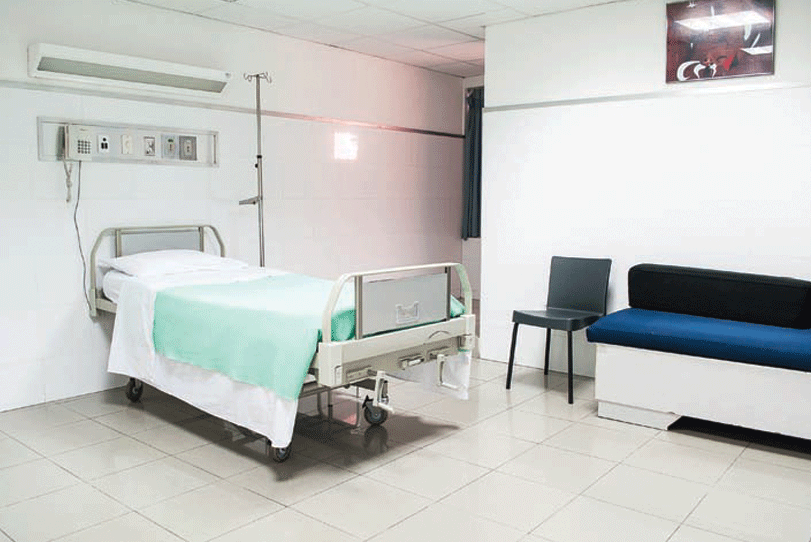This article highlights the various aspects need to be considered while we are upgrading building services of a hospital in the COVID era.
If we go back to the history of the world, so far we have faced so many wars but the World War I and World War II are the majors. The First World War is better known as the first mass killing of the 20th Century with an estimated 10 million military deaths alone but for the injured; doctors learned enough to vastly improve a soldier’s chances of survival. Ambulances, antiseptic, and anaesthesia, three elements of medicine taken entirely for granted today, emerged from the depths of suffering in the First World War.
In World War II, concept of mobile and fixed hospital came into place. Field hospitals (400 beds) and evacuation hospitals (400 or 750 beds) arrived within a few days of an invasion and followed the army, staying about thirty miles behind the front. They were close enough to treat patients quickly and send them back to the front quickly as well. These hospitals relied on mobility. They usually used canvas tents, but also used schools, barracks, hospital buildings, hotels, Mediterranean villas, and even an Italian stadium. The station hospitals (250, 500, or 750 beds), general hospitals (1,000 beds), and convalescent hospitals (2,000 or 3,000 beds) were set up far from the front to keep patients safe from danger, but also to keep them in the theatre, which made it easier to return the soldiers to duty. In England before D-day, field and evacuation hospitals waiting for the Normandy invasion functioned as station hospitals to care for patients.
The present situation is no less than any World War when the entire world is facing a big challenge. The same challenge is for in healthcare industry too. It is not only increased the number of COVID-19 patients but also affecting the inflow of other patients into the hospital. Even patients requiring regular follow up and review are unable to visit the hospital. While fighting COVID-19, reduction in viral reproduction number and increasing immunity is important. While doing this, people need to reach hospitals to get required healthcare services for their old and now new symptom is highly essential.
To cater this requirement, renew of the building services of existing healthcare units is important no matter the size, location and capacity of the existing facility. For making this possible, space rearrangement, staff management and inventory management for medical equipment is essential. And for functioning of above essential parts, renew and upgradation of building services is very much essential which includes uninterrupted electricity supply, DG and battery backup, air-conditioning and ventilation systems with post COVID-19 specific air treatment and public health system which comprises of water supply drainage and firefighting services. While fortunately HVAC systems have seen importance, but other building services kept on hold. The fact is that entire building services system is connected and inter dependent.
Various aspects need to be considered while we are upgrading building services of the hospital. We consider a scenario when no extra floor space is added in the hospital while upgrading.
Electrical system
Uninterrupted electricity supply: When we are not increasing floor space of the hospital or if we are not adding any special type of equipment to the main load like MRI and scanner, new electrical load will not increase. The COVID-19 testing and medication is not at least for now need any specific equipment which can consume extra electricity. So, net capacity of the transformer or diesel generator need not be required but we need to upgrade the UPS system for proper battery backup for most critical loads. When we will define any specific area for COVID-19 ward, as per requirement re arrangement of light, power, utility power and extra points can be provided while the hospital in operation. APFC panel, earthing system and lightning arrestor of the existing units have to be checked and if not working, then has to be repaired.
Air-conditioning and ventilation
The need to restrict air movement within and between various rooms especially when some areas are designated as COVID ward while normal patients are visiting for regular treatment.
• COVID wards to be maintained at 2 pascals to 8 pascals f positive air pressure.
• Air lock of as small as 20 sq. ft. will have to be provided with positive pressure difference from adjacent rooms.
• This pressure difference achieved though control of fresh air in all adjacent rooms.
• Each COVID room and ward has to be connected with 100 percent fresh air and 100 percent exhausts with a room temperature of 23 degree plus minus 1 degree Celsius with 50 percent to 55 percent relative humidity.
• The specific requirements for ventilation and filtration to dilute and remove contaminants in the form of airborne microorganisms, viruses, odour need to be done.
• Separate fans with individual ducting have to be provided in these rooms so that there is no mix of air take place.
• Two separate sets of dress changing room for entry and exit time zone need to create in each COVID ward with proper pressure difference.
• Entry zone changing room has to be neutral to corridor but positive to COVID ward however exit zone changing room has to be neutral to COVID ward but negative to corridor.
• No re circulation of air from this changing room is allowed.
• Two separate dress disposable boxes to need to be kept in these area.
• Different types of temperature and humidity requirements for various areas. It not possible with only VRV or ductable system (if existing facility has), then specialised de humidifiers need to install in different rooms to control the humidity.
• In waiting areas, we need to provide a healthy and lavish atmosphere to take care of COVID patient, especially when they are waiting for their turn to come. They should ne panic.
• The sitting space arrangement as per social distance norms but the entire waiting room has to be negative compared to inside corridor and neural to atmosphere.
• While designing the different rooms of the hospitals, we need to go through various alterations of design to achieve the goal while not compromising the technical responsibility as a consultant.
Control of infection sources and its measures majorly in COVID wards:
• Infectious bacteria are transported by air. Droplets or infectious agents of 5 mm or less in size can remain airborne indefinitely. It has been shown that 90 to 95 per cent effective filters remove 99.9 per cent of all bacteria present in hospitals. Epidemiological evidence and other studies indicate that many of the air borne viruses that transmit infections are sub- micron in size, thus there is no known method to effectively eliminate 100 per cent of the viable particles. HEPA filters and/or Ultra-Low Penetration (ULPA) filters provide the greatest efficiency currently available. Considering this, the isolation rooms with appropriate ventilation pressure relationships have provided to prevent the spread of airborne viruses in the hospital environment.
Use of 100 percent treated fresh air system in entire COVID ward and ASHRAE specific fresh air for entire premises:
• Treated fresh air (TFA) has a major role to play in hospitals. Outdoor air in comparison to room air is virtually free of bacteria and viruses. Infection control problems frequently involve a bacterial or viral source within the hospital.
• Ventilation air dilutes the viral and bacterial contamination within the hospital. Properly designed, constructed and maintained ventilation systems preserve the correct pressure relationship between functional areas; they remove airborne infectious agents from hospital environment.
• 100 percent treated fresh air to be provided in COVID ward and TFA as per ASHRAE standard (nearly @ 15 CFM per person) have to provide in all rooms and care to be taken that same amount of air get extracted through toilets fans all times, so that there is a continuous air change in the premises.
• Isolation Rooms (NICU): When COVID patients reached to critical stage, they need to shift to NICU rooms which have to be separated from other rooms. These patients help in various modes of transmission of contaminate the environment creating the necessity to control infections. For which standard pressure room- for patients who require contact or droplet isolation is provided.
• Negative pressure room – for patients who require airborne droplet nuclei isolation to reduce transmission of disease via the air-borne route (Class-N) is provided.
• Requirement of separate exhaust system dedicated NICU room, removing a quantity of air greater than that of the supply system have provided.
• Directs the exhaust directly to outside also provided with bypass connection.
• Rooms with a positive pressure relative to the ambient pressure to isolate immune compromised patients such as certain transplant and oncology patients have provided. The aim is to reduce the risk of airborne transmission of infection to susceptible patients (Class-P).
Importance of air lock function
It provides a barrier against loss of pressurisation and against entry/exit of contaminated air in/out of the isolation room when the door to the airlock is opened. It provides a controlled environment in which protective garments can be donned without contamination before entry into the isolation room. It also provides a controlled environment in which equipment and supplies can be transferred from isolation room without contaminating the surrounding areas.
Humidity Control
Bacteriological microorganisms ride on dust particles whose attract ability to one another is favoured by low relative humidity resulting in increased static energy. High humidity in the hospital enhances the danger of growth of Pseudomonas aeruginosa. Humidity in operation room is believed to contribute to the prevention of dehydration of exposed tissue. At relative humidity of about 50 per cent, a very thin invisible film of moisture forms on the operation equipment and other surfaces. This film of moisture conducts static electricity to earth before a spark producing potential is built up. To minimise the explosion risk, the relative humidity required is 40-65 per cent. VRV indoor units have installed with RH indication in the remote controls have provided along with few portable time dehumidifiers.
Public Health Engineering (PHE) systems
Hot and cold water supply, drainage, sewage treatment (STP), effluent treatment (ETP) and firefighting system comes under public health engineering services. When we are not increasing net floor space of the hospital, so there will be no change in firefighting system but there will be impact on plumbing services.
By adding COVID ward, we are expecting more patients in the premises, which will increase cold water supply and STP and ETP. But in general we don’t need to change STP but the existing ETP has to be modified with more layer of filtration as the discharge will add drainage from COVID ward too.
Specific area-wise rearrangement of water supply and drainage can be done, but it is always advices not do add any supply and drainage locations when it is not absolutely necessary as the pipe lines follow certain routes to reach the destinations and they follow the rule of gravity even as pumped once or twice.
Addition of toilets need to strictly avoided as it will disturb the entire water distribution network and improper drainage from the new points will create trouble in future.
Conclusion
The percentage of COVID patient is very much less to the number of patients who need treatment for other diseases. We need to face the outbreak of corona war like we faced World War I and World War II. However those wars had a very short period impact but this time we have to fight for a longer time. We can’t ignore other diseases while treating corona, so only healthy and active building services in existing hospitals can fight corona.
This article highlights the various aspects need to be considered while we are upgrading building services of a hospital in the COVID era.
Authored by:
Firoj Jena,Chief Executive Officer,
Clancy Global Consulting Engineers, Mumbai
Cookie Consent
We use cookies to personalize your experience. By continuing to visit this website you agree to our Terms & Conditions, Privacy Policy and Cookie Policy.















